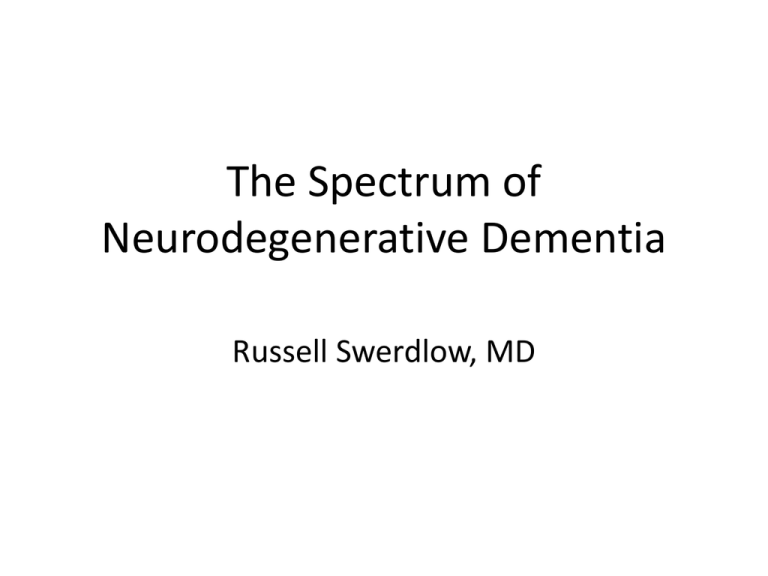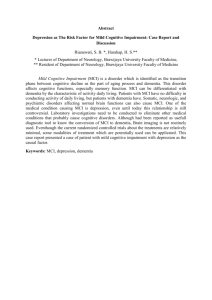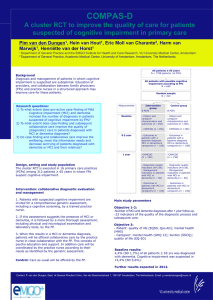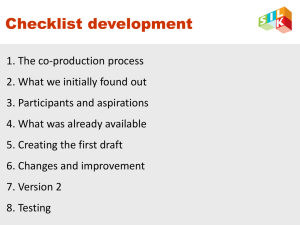The Spectrum of Neurodegenerative Dementia
advertisement

The Spectrum of Neurodegenerative Dementia Russell Swerdlow, MD NINCDS-ADRDA Criteria • Objective dementia • At least two defective cognitive domains • Progressive worsening • Normal consciousness • No other potential causes apparent *From McKhann et al, Neurology 34, 939-944. Cognitive Domains • • • • • • • Judgment and Reasoning Attention and concentration Praxis Executive Language Visuospatial Memory Memory Attention Working memory/Attention/ Executive Functioning Memory Language/Executive Function/ Praxis Visuospatial Function Other Studies • Brain imaging – CT or MRI • Blood tests – CBC, chemistries, LFTs, B12, thyroid Gene and Biomarker Testing • • • • May help increase certainty of diagnosis May decrease certainty of diagnosis May help predict MCI-to-AD conversion Being developed to facilitate/refine early dx – These efforts are primarily for research purposes Available Gene/Biomarker Tests • • • • Genetic Testing FDG PET CSF Amyloid PET AD Biomarker “Definitions” • “Upstream” Biomarkers – CSF Abeta – Brain amyloid imaging by amyloid PET • “Downstream” Biomarkers – Tau or phospho-tau – FDG PET – MRI 2011 AD Criteria • Probable AD Dementia – Meets clinical AD criteria – No alternate diagnosis – Documented decline, biomarker, or mutation • Possible AD Dementia – Meets clinical AD criteria, BUT – Atypical course (lacks clear progression) OR – Biomarkers are negative OR – Mixed presentation (criteria for other cause also met) 2011 MCI Clinical Criteria • Concern regarding a change in cognition – By patient, informant, or clinician • Impairment in 1 or more cognitive domains – Typically 1-1.5 SD below expected • Preserved independence in functional abilities – Mild problems allowed, but essentially independent • Not demented – No evidence of social or occupational impairment 2011 MCI Criteria: Types of MCI • MCI of a Neurodegenerative Etiology – Meets MCI clinical criteria, BUT – Biomarkers not tested, OR – Biomarkers tested but are ambiguous for AD, OR – Biomarkers tested but are negative for AD • MCI of the Alzheimer Type – Meets MCI clinical criteria, AND – At least 1 AD “downstream” biomarker is present • Prodromal Alzheimer’s Dementia – Meets MCI clinical criteria, AND – There is “upstream” AD biomarker evidence 2011 Preclinical AD Criteria • Stage 1 (Asymptomatic Cerebral Amyloidosis) – Abnormal “upstream” biomarker – Normal cognition • Stage 2 (Amyloidosis+Degeneration) – Abnormal “upstream” biomarker – Abnormal “downstream” marker – Normal cognition or slight decline • Stage 3 (Amyloidosis+Degeneration+Cognitive Change) – Abnormal “upstream” biomarker – Abnormal “downstream” biomarker – Longitudinal evidence of subtle cognitive decline (A) (B) 100 (between 30-50%) Percent Effected 60 20 with MCI* (between 10-30%) 40 (+Standard Deviation) 40 with clinical AD 100 90 80 70 60 50 40 30 20 10 0 Clinical AD 25 with preclinical AD (~65% of those with no cognitive decline) 15 with no AD Clinical AD + MCI Clinical AD + MCI + Preclinical AD AD Treatments • • • • • Cholinesterase inhibitors Memantine Axona Dietary Supplements Amyloid Treatments FTD: Clinical Criteria (1) Acquired behavioral or cognitive deficits of a) personality, with inappropriate activities, or b) progressive language change -problems with expression -problems with word meaning/naming (2) (3) (4) (5) (6) Decline causes social/occupational dysfunction Insidious and progressive Degenerative in nature (no other etiology) Not delirious Not due to psychiatric disturbance McKhann et al, Arch Neurol 2001;58:1803-1809 Primary Progressive Aphasia • Inclusion Criteria (all required) – Language main clinical feature – Language main cause of ADL problems – Problems started with language • Exclusion Criteria (all required) – Other medical disorder is more likely – Psychiatric disorder is more likely – Other cognitive domains initially perturbed – Prominent initial behavioral disturbances Non-Fluent/Agrammatic Variant PPA • At least 1 of 3 core features – Agrammatism – Effortful, halting speech; apraxia of speech • At least 2 of 3 – Impaired comp. of syntactically complex sentences – Spared single word comprehension – Spared object knowledge • Imaging Support – Left posterior frontal-insular atrophy – Left posterior frontal-insular hypometabolism Semantic Variant PPA • Both core features present – Impaired confrontation naming – Impaired single word comprehension • At least 3 present – – – – Impaired object knowledge Surface dyslexia or dysgraphia Spared repetition Spared speech production • Imaging Support – Predominant anterior temporal lobe atrophy – Predominant anterior temporal lobe hypometabolism Logopenic Variant PPA • Both core features present – Impaired single word retrieval – Impaired repetition • At least 3 features present – Errors in spontaneous speech and naming – Spared single word comp./object knowledge – Spared motor speech – Absence of frank agrammatism • Imaging support – Left posterior perisylvian/parietal atrophy – Left posterior perisylvian/parietal hypometabolism PPA Etiology Predictions • Non-fluent/agrammatic – Most often tau-postitive – FTLD spectrum (may evolve into CBD or PSP) – If familial, consider checking MAPT gene; also PGRN gene • Semantic – Most often TDP – FTLD spectrum – If familial, consider checking PGRN gene • Logopenic – Most often AD pathology – Could consider checking for AD biomarkers Behavioral Variant FTD Criteria • Progressive deterioration of behavior/cognition • Possible bvFTD (need 3 of 6) – – – – – – Disinhibition (lost social skills, manners, impulsive) Apathy or inertia Lost sympathy or empathy Stereotyped or compulsive/ritualistic behaviors Hyperorality/dietary changes NP with executive >memory and VP dysfunction • Probable bvFTD – Meets possible bvFTD criteria – Exhibits significant functioanl decelin – Imaging c/w bvFTD (frontal/anterior temporal atrophy or hypomet.) bvFTD • Biggest recent finding: – C9ORF72 – Familial and sporadic cases reported – Especially prevalant in familial FTD-MND Dementia with Lewy Bodies • Central feature – Progressive dementia • Core features (2 for probable, 1 for possible) – Fluctuating cognition/variable attention+alertness – Recurrent visual hallucinations – Spontaneous features of parkinsonism • Suggestive features (almost equal weight) – REM sleep behavior disorder – Severe neuroleptic sensitivity – Low dopamine transporter uptake in BG • Supportive features – Falls, LOC, autonomic dysfunction, delusions Temporal Sequence • DLB: dementia before or with parkinsonism • PDD: dementia evolves after PD established Pre-Mortem DLB vs. AD • • • • Dopamine transporter (DAT) imaging Metaiodobenzyl guanidine (MIBG) scintigraphy FDG PET (occipital hypometabolism) Relative hippocampal sparing on MRI Post Mortem DLB vs. AD • 60% of time AD and LB pathology co-exist Cogniform Disorder • Complaints/performance issues excessive (need 2 of 9) – Mild-mod injury with deficits worse than expected – Inconsistencies between complaints, deficits, injury – Inconsistencies between deficits and observed state – Temporal course not typical of that expected – Inconsistencies across multiple evaluations – Strange patterns on cog testing – Inconsistencies in sx or complaints over time – Issues with specific Validity tests (e.g. testing of effort) – Issues with parts of other tests that inform Validity • Deficits play out in everyday life – In addition to excessive complaints/poor testing on eval, sx pervade daily function (“sick role”) • Specify if: – Evidence of external incentive, interpersonal incentive, or NOS MEMORY CIRCUIT Dorsolateral Prefrontal Area (Brodmann’s 9 and 10) Glu Dorsolateral Head of Caudate GABA GPe GABA GABA STN Glu Medial Temporal Lateral Dorsomedial GPi; SNR Lobe GABA Parahippo. Gyrus Hippocampus VA and DM Thalamus Entorhinal Cortex Medial Temporal-Thalamic Circuit (memory storage) DorsolateralPrefrontal Pathway (memory activation and search functions) References • AD – – – McKhann GM, Knopman DS, Chertkow H, et al. The diagnosis of dementia due to Alzheimer's disease: Recommendations from the National Institute on Aging-Alzheimer's Association workgroups on diagnostic guidelines for Alzheimer's disease. Alzheimers Dement 2011;7:263-269. Albert MS, Dekosky ST, Dickson D, et al. The diagnosis of mild cognitive impairment due to Alzheimer's disease: Recommendations from the National Institute on Aging-Alzheimer's Association workgroups on diagnostic guidelines for Alzheimer's disease. Alzheimers Dement 2011;7:270-279. Sperling RA, Aisen PS, Beckett LA, et al. Toward defining the preclinical stages of Alzheimer's disease: Recommendations from the National Institute on Aging-Alzheimer's Association workgroups on diagnostic guidelines for Alzheimer's disease. Alzheimers Dement 2011;7:280-292. • PPA – Gorno-Tempini ML, Hillis AE, Weintraub S, et al. Classification of primary progressive aphasia and its variants. Neurology 2011;76:1006-1014. • bvFTD – Rascovsky K, Hodges JR, Knopman D, et al. Sensitivity of revised diagnostic criteria for the behavioural variant of frontotemporal dementia. Brain 2011;134:2456-2477. • DLB – McKeith IG, Dickson DW, Lowe J, et al. Diagnosis and management of dementia with Lewy bodies: third report of the DLB Consortium. Neurology 2005;65:1863-1872. • Cogniform Disorder – Delis DC, Wetter SR. Cogniform Disorder and Cogniform Condition: proposed diagnoses for excessive cognitive symptoms. Arch Clin Neuropsychol 2007;22:589-604.











